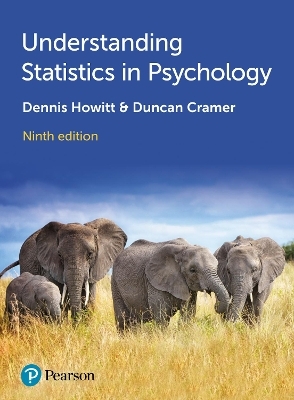
Understanding Statistics in Psychology
Pearson Education Limited (Verlag)
978-1-292-46518-0 (ISBN)
Now in its ninth edition, Understanding Statistics in Psychology, by Dennis Howitt and Duncan Cramer continues to provide an accessible introduction to the intimidating subject of statistics in psychology for students of all years and abilities.
Clear explanations and diagrams break down the statistical techniques that are used in modern psychological research and updated examples of real-life studies bring the topic to life by showing you how statistics are used in practice.
The new software-agnostic approach of this edition means that you will gain a solid understanding of statistics which can be applied to whichever statistical package you are using to analyse your data. The modular structure of this text and its small accessible chapters also mean that it is easy to dip in and out of, concentrating on the techniques that are the most relevant for you and your own research projects.
This text does not just focus on how to analyse data but also contains clear and detailed guidance of the whole research process, from how to choose the appropriate tests, to interpreting your findings and successfully writing up your research.
Dennis Howitt is a reader in Psychology at Loughborough University, a chartered forensic psychologist and fellow of the British Psychological Society, with a specific interest in the study of mass communications and the application of psychology to social issues. Duncan Cramer is an emeritus professor at Loughborough University with a specific interest in topics such as mental health, personality, personal relationships, organizational commitment, psychotherapy and counselling.
Preface
Why statistics?
Part 1 Descriptive statistics
Some basics: Variability and measurement
Describing variables: Tables and diagrams
Describing variables numerically: Averages, variation and spread
Shapes of distributions of scores
Standard deviation and z-scores: Standard unit of measurement in statistics
Relationships between two or more variables: Diagrams and tables
Correlation coefficients: Pearson’s correlation and Spearman's rho
Regression: Prediction with precision
Part 2 Significance testing
Samples from populations
Statistical significance for the correlation coefficient: Practical introduction to statistical inference
Standard error: Standard deviation of the means of samples
Related or paired-samples t-test: Comparing two samples of related/correlated/paired scores
Unrelated or independent-samples t-test: Comparing two samples of unrelated/uncorrelated/independent scores
What you need to write about your statistical analysis
Confidence intervals
Effect size in statistical analysis: Do my findings matter?
Chi-square: Differences between samples of frequency data
Probability
One- versus two-tailed or -sided significance testing
Ranking tests: Nonparametric statistics
Part 3 Introduction to analysis of variance
Variance ratio test: F-ratio to compare two variances
Analysis of variance (ANOVA): One-way unrelated or uncorrelated ANOVA
ANOVA for correlated scores or repeated measures
Two-way or factorial ANOVA for unrelated/uncorrelated scores: Two studies for the price of one?
Multiple comparisons in ANOVA: A priori and post hoc tests
Mixed-design ANOVA: Related and unrelated variables together
Analysis of covariance (ANCOVA): Controlling for additional variables
Multivariate analysis of variance (MANOVA)
Discriminant (function) analysis – especially in MANOVA
Statistics and analysis of experiments
Part 4 More advanced correlational statistics
Partial correlation: Spurious correlation, third or confounding variables, suppressor variables
Factor analysis: Simplifying complex data
Multiple regression and multiple correlation
Path analysis
Analysis of a questionnaire/survey project
Part 5 Assorted advanced techniques
Meta-analysis: Combining and exploring statistical findings from previous research
Reliability in scales and measurement: Consistency and agreement
Influence of moderator variables on relationships between two variables
Statistical power analysis: Getting the sample size right
Part 6 Advanced qualitative or nominal techniques
Log-linear methods: Analysis of complex contingency tables
Multinomial logistic regression: Distinguishing between several different categories or groups
Binomial logistic regression
Part 7 Bringing things together
Data mining and Big Data
Towards a masterplan
Appendices
Glossary
References
Index
| Erscheinungsdatum | 12.11.2024 |
|---|---|
| Verlagsort | Harlow |
| Sprache | englisch |
| Themenwelt | Geisteswissenschaften ► Psychologie ► Test in der Psychologie |
| ISBN-10 | 1-292-46518-2 / 1292465182 |
| ISBN-13 | 978-1-292-46518-0 / 9781292465180 |
| Zustand | Neuware |
| Haben Sie eine Frage zum Produkt? |
aus dem Bereich


